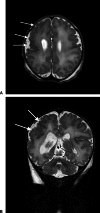Polymicrogyria and congenital parvovirus b19 infection
- PMID: 23705097
- PMCID: PMC3653533
- DOI: 10.1055/s-0031-1285984
Polymicrogyria and congenital parvovirus b19 infection
Abstract
Fetal parvovirus B19 infection causes anemia, hydrops, and pregnancy loss but is generally not considered teratogenic. Nevertheless, disturbances of neuronal migration have been described with congenital parvovirus infection. We evaluated a term infant with congenital parvovirus disease and polymicrogyria. We compared this case with four other reports of central nervous system disease after birth to parvovirus-infected mothers. After an extensive diagnostic evaluation, this infant was found to have congenital parvovirus disease with severe anemia and nonimmune hydrops as well as extensive polymicrogyria. Although rare, this report and literature review suggest that parvovirus B19 has the potential to disrupt normal neurodevelopment. We suggest that infants with severe congenital parvovirus infection have close developmental surveillance and if symptomatic undergo neuroimaging to assess for disorders of neuromigration.
Keywords: Parvovirus; congenital infection; polymicrogyria; teratogen.
Figures
Similar articles
-
Parvovirus B19 infection during pregnancy and risks to the fetus.Birth Defects Res. 2017 Mar 15;109(5):311-323. doi: 10.1002/bdra.23588. Birth Defects Res. 2017. PMID: 28398685 Review.
-
Parvovirus B19 Intrauterine Infection and Cerebral Cortical Dysplasia: A Case Report.Curr Pediatr Rev. 2025 Apr 14. doi: 10.2174/0115733963349333250407065521. Online ahead of print. Curr Pediatr Rev. 2025. PMID: 40231508
-
Parvovirus B19 in pregnancy.Reprod Toxicol. 2006 May;21(4):421-35. doi: 10.1016/j.reprotox.2005.01.006. Reprod Toxicol. 2006. PMID: 16580942 Review.
-
Polymicrogyria in a fetus with human parvovirus B19 infection: a case with radiologic-pathologic correlation.Ultrasound Obstet Gynecol. 2012 Nov;40(5):604-6. doi: 10.1002/uog.11121. Ultrasound Obstet Gynecol. 2012. PMID: 22344957
-
Parvovirus B19 infection in pregnancy.J Obstet Gynaecol Can. 2014 Dec;36(12):1107-1116. doi: 10.1016/S1701-2163(15)30390-X. J Obstet Gynaecol Can. 2014. PMID: 25668048
Cited by
-
Parvovirus B19 Infection and Pregnancy: Review of the Current Knowledge.J Pers Med. 2024 Jan 26;14(2):139. doi: 10.3390/jpm14020139. J Pers Med. 2024. PMID: 38392573 Free PMC article. Review.
-
From Fetal to Neonatal Neuroimaging in TORCH Infections: A Pictorial Review.Children (Basel). 2022 Aug 11;9(8):1210. doi: 10.3390/children9081210. Children (Basel). 2022. PMID: 36010101 Free PMC article. Review.
-
Updating an Overview of Teratology.Methods Mol Biol. 2024;2753:1-38. doi: 10.1007/978-1-0716-3625-1_1. Methods Mol Biol. 2024. PMID: 38285332
References
-
- Young N S, Brown K E. Parvovirus B19. N Engl J Med. 2004;350:586–597. - PubMed
-
- Enders M, Weidner A, Zoellner I, Searle K, Enders G. Fetal morbidity and mortality after acute human parvovirus B19 infection in pregnancy: prospective evaluation of 1018 cases. Prenat Diagn. 2004;24:513–518. - PubMed
-
- Kumar M L, Abughali N F. Perinatal parvovirus B19 infection. NeoReviews. 2005;6:32–37.
-
- Pistorius L R, Smal J, de Haan T R. et al.Disturbance of cerebral neuronal migration following congenital parvovirus B19 infection. Fetal Diagn Ther. 2008;24:491–494. - PubMed
-
- Guerrini R, Parrini E. Neuronal migration disorders. Neurobiol Dis. 2010;38:154–166. - PubMed
Publication types
LinkOut - more resources
Full Text Sources


